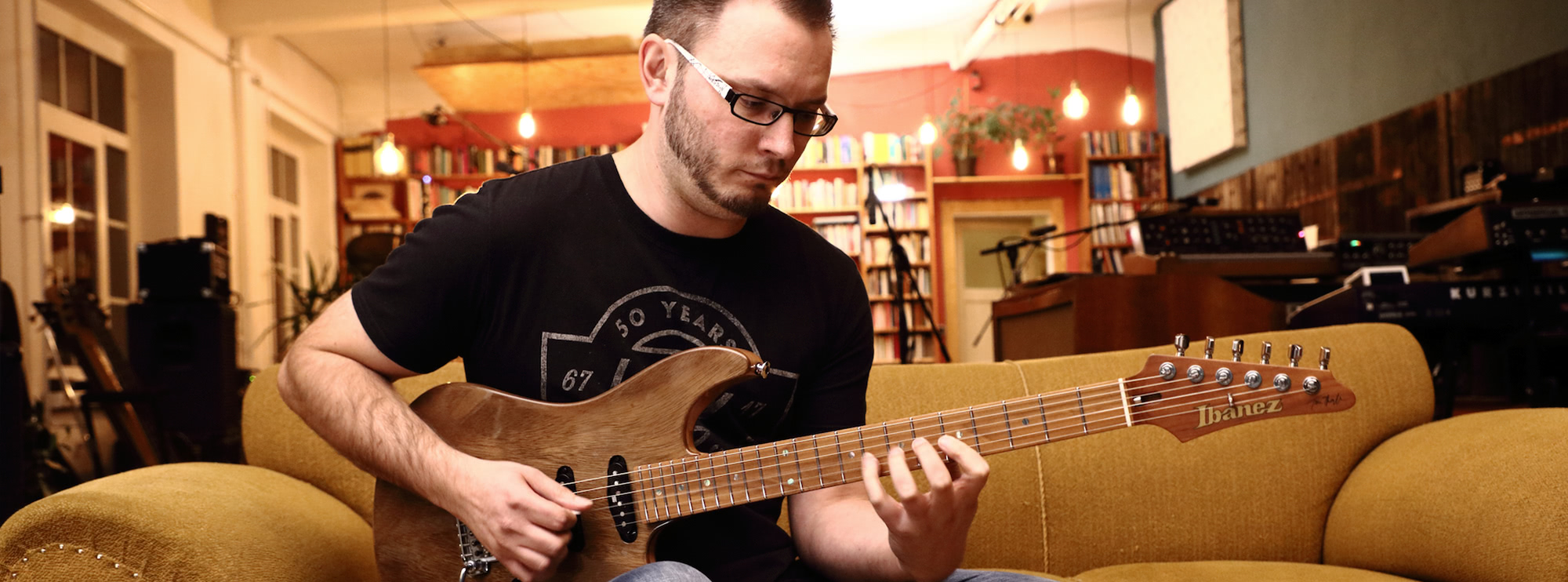Peter Green - Tech Session by Nick Jennison
Welcome to "Peter Green - Tech Session" by Nick Jennison, an immersive guitar lesson series designed to capture the essence of Peter Green’s iconic playing style. This course offers a comprehensive approach to learning guitar techniques that will elevate your playing to new heights. With in-depth lessons and dynamic performances, you'll not only master technical skills but also gain insights into their application in real musical contexts.
Lesson Overview
In this series, Nick Jennison meticulously breaks down the nuances of Peter Green's playing. Each lesson focuses on specific techniques that defined Green’s sound, making it accessible for guitarists of all levels. From expressive vibrato to intricate finger-picking, you'll learn to incorporate these elements into your own playing.
Vibrato
Vibrato is one of the most expressive techniques in a guitarist's arsenal. Peter Green's use of vibrato adds emotion and depth to his solos. In these lessons, Nick teaches how to execute and control vibrato to enhance your musical expression. Mastering this technique will allow you to add a personal touch to your playing, making your solos more compelling and emotionally resonant.
Alternate Picking
Alternate picking is essential for achieving speed and precision. This technique involves alternating downstrokes and upstrokes, which Nick demonstrates in the context of Peter Green’s fluid playing style. Learning alternate picking will improve your picking accuracy and efficiency, enabling you to play complex passages with ease and fluidity.
Legato
Legato playing involves smooth, connected notes achieved through hammer-ons and pull-offs. Peter Green often used legato to create seamless, flowing lines. These lessons will help you develop a fluid playing style, reducing the reliance on picking and allowing for faster, more melodic lines.
Finger-Picking
Finger-picking is integral to Peter Green’s bluesy style. Nick covers various finger-picking patterns that Green employed, offering detailed instruction on achieving the right hand technique. By mastering finger-picking, you can add a rich, textured layer to your playing, perfect for blues and folk styles.
String Bending
String bending is crucial for adding expressiveness to your solos. Green’s bending techniques are dissected to show how to achieve pitch-perfect bends. Learning string bending will enhance your ability to convey emotion in your solos, making your notes sing with vibrato and sustain.
Performance Insights
In addition to lessons, this series includes performances by Nick Jennison, showcasing the techniques in a musical context. Watching these performances is invaluable for understanding how techniques come together in real-time playing. Seeing Nick apply these skills in full performances will inspire you and provide practical examples of how to integrate these techniques seamlessly into your own music.
Technique List
Here is a comprehensive list of guitar techniques covered in the "Peter Green - Tech Session" by Nick Jennison. Click on each link to dive deeper into these techniques and understand their applications:
- Vibrato
- Alternate Picking
- Legato
- Finger-Picking
- String Bending
- Hammer-Ons
- Pull-Offs
- Slides
- Double Stops
- Unison Bends
- Bluesy Bends
- Arpeggios
- Chord Progressions
- Pinched Harmonics
By engaging with these lessons, you will not only learn to play like Peter Green but also gain a deeper understanding of the techniques that make his style so unique and influential. Whether you’re a beginner or an experienced player, these lessons offer valuable insights that will enhance your guitar playing journey. Join Nick Jennison in this detailed exploration of Peter Green's legendary techniques and transform your approach to guitar playing.
THE GEAR:
Green's legendary '59 Les Paul contributed a great deal to his signature tone with it's out of phase middle position, where the two pickups cancel each other out, creating a hollow and quacky tone. Of course, you don't need a 1959 Les Paul to get close to that signature sound! We used Vintage's excellent V100 Lemon Drop guitar which features the same out of phase mod, but any dual humbucker guitar will do the trick - especially if it has a volume control for each pickup! The crucial part of making the out of phase sound work is rolling down one of the volume controls until the sound "fattens up".
Perhaps surprisingly, the amp we used was a Victory VX100 Super Kraken. While this is ostensibly a high gain rock and metal amp, it's British-sounding clean channel cranked up full produced just the right flavour, especially when combined with a spring reverb pedal ran into the front of the amp. Not only does this exaggerate the reverb tail to Green-esque levels of wetness (he used a LOT of reverb!), it also helps with both sustain and the "sponginess" of the play feel, which is critical for emulating Green's expressive style. Lastly, we recorded this session LOUD! Sadly, playing loudly is about the only way to get those sustained notes around bar 37 without cranking the distortion, but just about everything else in this session should be easily achievable without upsetting your neighbours.
VIBRATO:
Like we discussed in the Peter Green feature that accompanies this Tech Session, Green's signature vibrato is at the core of his style. In terms of execution, it's less of a series of bends and releases and more of a controlled "shake". Staking relaxed is important, because the "shake" needs to be completely even in both speed and width, or you run the risk of sounding terrible. The technical line between "Green God" and "nervous sheep" is very fine, but the sonic difference is night and day.
BARS 1-11:
We kick things off by looking at some "Green Manalishi" inspired thunder. These two note chords (root and third) are very common in Green's playing, and sound suitably ominous when layered over the ringing open E string. Use a little palm muting to help the E string "pop", but keep it light - this isn't modern metal chugging.
BARS 12-23:
An example of some of Green's more aggressive blues phrasing, inspired by his work on "Black Magic Woman". While Green's known for his restraint and simplicity, he wasn't afraid to "busy it up" if the song called for it.
Now, remember when we said that this session would be less about learning the notes and more about *how* they're played? Well, this section is all about that. What separates the way Green would play these tried-and-true blues lines from the way other players would approach them is his touch and timing. There are parts that are going to be bang-on-in-time (like bar 17), and other parts that will be way behind the beat (like bar 14). Listen carefully for which is which and you'll start to develop an instinct for when to lock up and when to be loose.
Likewise, your right hand dynamics are crucial to making these licks sound authentically "Green". Your touch should be light for the most part, but there will be notes (marked as accents in the tab) where you should lay in a little more to open up the tone. If you've dialled your pickup balance just right, you'll notice a distinctly different sound between the louder and softer notes, along with a "singing" quality to the decay on the vibrato.
Also, pay attention to the Gm arpeggio in bar 19: While the bulk of Green's blues soloing was almost exclusively pentatonic, he knew exactly how to "hit the changes" when he wanted to: further proof that his sparse style was born of choice and not ignorance - be sure you don't get it twisted and use Green's impeccable taste as an excuse not to study!
BARS 24-25:
Here we have "that sound" from Black Magic Woman. Roll your neck volume control down just a touch, and play very gently while shaking the guitar's neck to produce a subtle chorusing sound as the reverb tail decays.
BARS 26-36:
This second pass showcases Green's approach to "filling in" around a vocal (inspired by the verses of "I Loved Another Woman"). The lines are deliberately sparse and clean so as not to detract from either the moody quality of the track or the hypothetical vocal line.
We'll keep the neck volume rolled back a little, but we can't go too far with this or the sound will get too "phasey" and thin. To keep these lines clean, you're going to have to play so gently that you might find yourself missing the string entirely - a great test of your control!
BARS 37-47:
Here we're going to explore the soaring sustain of "The Supernatural". Because we can't crank up a high gain amp, we're going to have to get some sustain the old school way - with vibrato and feedback. Unfortunately, you're going to need to shift a bit of air to make this work, since the vibration from your amp will cause the guitar's strings to keep vibrating like a bowed violin. Vibrato will help here too since the friction of the string against the fret will have a similar "bowing" effect.
Here's a bit of trivia for you: If you've ever been to a gig and noticed a few spots on the stage with an "X" marked in tape, that's the spot where the physical interaction between the amp and guitar produce the best sustain. The "X" is there so the guitarist knows where to stand when it's time to sustain a long note (that's how Gary Moore did it!).
If you can't crank things up crazy loud, try touching your guitar's headstock to your speaker cabinet while you hold these sustained notes - the vibration of the cab will transfer into your guitar's neck and produce a similar effect to cranking things up really loud.
BARS 48-53:
More "Manalishi" inspired riffing here, using the same two note chord shapes and light palm muting as the intro. We're outlining the moody sound of the aeolian mode, but pay attention to the slid in bar 50 though - the D# implies harmonic minor for even more drama.
BARS 54-62:
Here we've got some "Oh Well" inspired single note blues riffs, but notice how well it jives with the more spacious parts of "Green Manalishi" (1:48 on the original recording). Be sensitive with your dynamics - play the first two times with a medium attack, and lay in harder on second two times to match what's going on in the accompaniment.
BARS 63-79:
Of course, we couldn't have a Peter Green tech session without looking at his soulful major blues phrasing on "Need Your Love So Bad". Roll back your neck volume a little and be super sensitive with both your timing and right-hand touch. There are notes where you'll need to dig in (like the high bend in bar 67), but for the most part you should use a very gentle touch and a laid back, behind-the-beat time feel. Just because the phrases are simple, doesn't mean they're easy!
So there you have it! Peter Green in a nutshell. Of course, describing Green's style in words and tablature is like trying to taste a gourmet meal by reading the recipe - it's way more than the sum of its parts! When you're learning anything by Peter Green, keep his philosophy in mind - the lines are simple so you can focus on the expression and dynamics. It's not enough to just "play the notes". A valuable lesson we could all do well to remember!

About The Tutor
Tutor Profile
Nick Jennison
I’m Nick Jennison, a guitarist, vocalist, producer and educator from the North East of England. It’s pretty cold up here, which seems like the perfect excuse to stay inside and make a bunch of great guitar-related videos for your viewing pleasure. I’ll be covering topics from technique, tone and musicality,...




